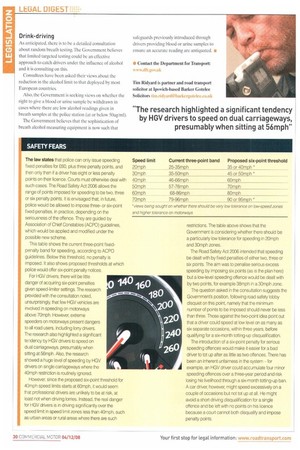SAFETY FEARS The law states that police can only issue
Page 30

If you've noticed an error in this article please click here to report it so we can fix it.
speeding fixed penalties for MO, plus three penalty points, and then only then if a driver has eight or less penalty points on their licence. Courts must otherwise deal with such cases. The Road Safety Act 2006 allows the range of points imposed for speeding to be two, three or six penalty points. It is envisaged that, in future, police would be allowed to impose threeor six-point fixed penalties, in practice, depending on the seriousness of the offence. They are guided by Association of Chief Constables (ACP0) guidelines, which would be applied and modified under the possible new scheme.
This table shows the current three-point fixedpenalty band for speeding, according to ACP° guidelines. Below this threshold, no penalty is imposed. It also shows proposed thresholds at which police would offer six-point penalty notices, For HGV drivers, there will be little danger of acquiring six-point penalties given speed-limiter settings. The research provided with the consultation noted, unsurprisingly, that few HGV vehicles are involved in speeding on motorways above 70mph. However, extreme speeders on motorways present dangers to all road users, including lorry drivers. The research also highlighted a significant tendency by HGV drivers to speed on dual carriageways, presumably when sitting at 56mph. Also, the research showed a huge level of speeding by HGV drivers on single carriageways where the 40mph restriction is routinely ignored.
However, since the proposed six-point threshold for 40mph speed limits starts at 60mph, it would seem that professional drivers are unlikely to be at risk, at least not when driving lorries. Instead, the real danger for HGV drivers is in driving significantly over the speed limit in speed limit zones less than 40mph, such as urban areas or rural areas where there are such
restrictions. The table above shows that the Government is considering whether there should be a particularly low tolerance for speeding in 20mph and 30mph zones.
The Road Safety Act 2006 intended that speeding be dealt with by fixed penalties of either two, three or six points. The aim was to penalise serious excess speeding by imposing six points (as is the plan here) but a low-level speeding offence would be dealt with by two points, for example 38mph in a 30mph zone.
The question asked in the consultation suggests the Government's position, following road safety lobby disquiet on this point, namely that the minimum number of points to be imposed should never be less than three. Those against the two-point idea point out that a driver could speed at low level on as many as six separate occasions, within three years, before qualifying for a six-month totting-up disqualification.
The introduction of a six-point penalty for serious speeding offences would make it easier for a bad driver to tot up after as little as two offences. There has been an inherent unfairness in the system for example, an HGV driver could accumulate four minor speeding offences over a three-year period and risk losing his livelihood through a six-month totting-up ban. A car driver, however, might speed excessively on a couple of occasions but not tot up at all. He might avoid a short driving disqualification for a single offence and be left with no points on his licence because a court cannot both disqualify and impose penalty points.




















































































































































